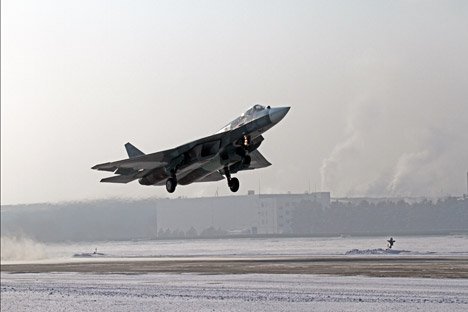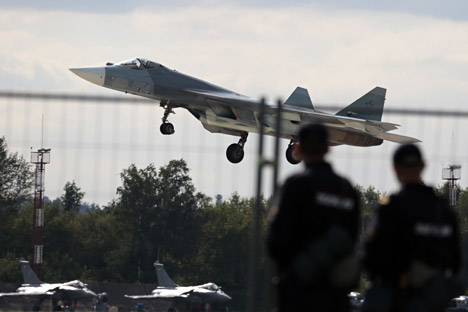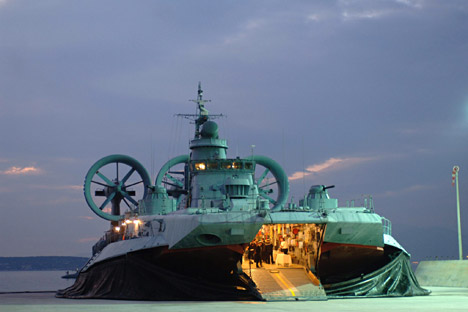PAK FA fighter jets: 6 years of 5th generation flights

A Sukhoi PAK FA (Sukhoi T-50) during a take off, Komsomolsk-on-Amur, Jan. 17, 2013.
TASSThe PAK FA project became one of the main drivers in the recovery of the country’s defense capacities. Modern production facilities were constructed and R&D was conducted, which revived the Russian aviation construction school.
The PAK FA project was based on already established technologies used in another project, Russia’s first fifth-generation fighter – the MiG 1.44 – and on the technology demonstrator Su-47. From the first project the PAK FA got its engine and from the second it acquired technology for the manufacturing of composite parts. Many components of the new fighter were created in the course of the modernization of the Su-27, which in its latest modifications – the Su-30SM and Su-35S – approached fifth generation capabilities. Fourteen years have passed since the start of the project and Russian Aerospace Forces have yet to receive one such jet fighter.
Tests are protracted
The PAK FA project today consists of five flying prototypes and three copies used for conducting ground testing. Three additional aircraft are currently under construction and testing work is already close to completion. At least this is what Deputy Defense Minister Yury Borisov announced in December 2015.
Moreover, modernized Soviet air-to-air medium and long-range missiles (modernized Soviet R-73 or RVV-MD and the R-37 or RVV-BD) created for the PAK FA as well as for fourth-generation fighter planes should have gone into mass production by the end of 2015. No one is sure if this has occurred as planned. Optimized for the PAK FA, the anti-radar KH-58UShK missile, which was created on the basis of the Kh-58 missile that went into service in 1978, is also still being tested.
New types of aircraft ammunition from the Grom (Thunder) project, created specifically for the PAK FA, will be delivered to the armed forces no earlier than 2017.
When will it go into service?
Given all the current problems, the Ministry of Defense has decided to reduce its purchases of the PAK FA in favor of the cheaper and already proven SU-35S fighter planes.
“Yes, we are reducing our purchases of the PAK FA fighter, and in the coming years, we will buy only one squadron,” Borisov said in July 2015.
A squadron in the Russian Aerospace Forces consists of 12 aircraft. It is interesting to note that in May 2015, the Russian Air Force Commander Viktor Bondarev said that the military was ready to buy “as many PAK FA fighters as the manufacturing industry could build.”
It seems that either the economic situation, or the modest pace of development of the PAK FA program, or a combination of these factors, has forced the Ministry of Defense to reconsider its previous plans. Nothing has changed since the end of 2015 and proof of this is the fact that before the New Year they announced the signing of a contract to buy 50 additional Su-35S planes.
The fact that the program has been experiencing delays and facing difficulties that directly arose in 2015, is reflected in the postponement of the adoption of this aircraft into service. In May 2015,Bondarev announced, and in summer of 2015 Borisov confirmed, that the aircraft would begin to appear in the armed forces in 2016. Then in December 2015, Bondarev announced that the delivery of the PAK FA to the armed forces would begin only in 2017.
Immediate prospects
The refusal by the Ministry of Defense to purchase large batches of PAK FA before the aircraft is fully ready is quite understandable, especially since the Russian military has had previous experience operating Mi-28N helicopters without onboard radar and Ka-52 helicopters without anti-tank Vikhr (Whirlwind) missiles.
These problems were resolved, but the repetition of a similar situation with a much more expensive aircraft would not be rational in terms of the overall preparedness of the aerospace forces. At the same time, a small initial batch would allow military pilots to develop warfare and operational tactics by the year 2020 when the aircraft will receive its new weapons, full-fledged radar and most importantly, the so-called “second stage engines.” These engines will provide the PAK FA with one of the key features of a fifth generation fighter – a supersonic flight without the use of afterburners.
Read more: What’s new with the Russian army?
All rights reserved by Rossiyskaya Gazeta.
Subscribe
to our newsletter!
Get the week's best stories straight to your inbox

